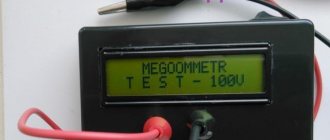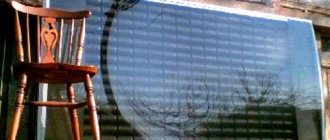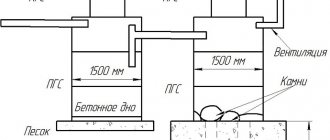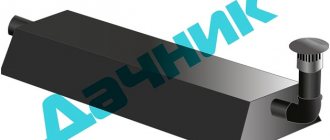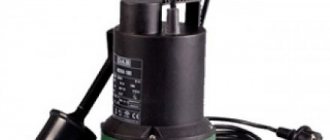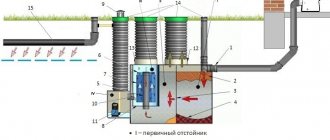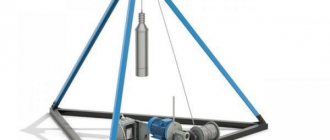01.07.2021
Septic tank
Editorial staff of the “New Place” website
Share
From this article you will learn
:
- Types of bacteria for septic tanks
- Basic principles of anaerobic treatment
- Features of aerobic cleaning
- The essence of bioactivators
- Type of bacteria according to purpose
- Frequency of use of bacteria for septic tanks
Private houses and garden houses often cannot be connected to a centralized sewer system. Therefore, the issue of recycling household waste is very relevant for them. Septic tanks come to the rescue, accumulating waste products, organic and inorganic waste. For their proper processing, microorganisms are needed that break down fats, eliminate unpleasant odors, and accelerate the decomposition of organic substances.
These biological products are much safer than chlorine-based products, which can also be used for disinfection. Unlike the latter, which negatively affect the condition of the soil, bacteria for septic tanks do not harm plants and humans. Read more about them below.
Types of bacteria for septic tanks
The basis of waste treatment in cesspools is always the organic process of decomposition of substances with the help of various bacteria. They separate the residues into water, carbon dioxide, nitrogen, nitrites and other components. For sewer systems, only natural components are used - dry squeeze of bacteria.
If active microorganisms are additionally placed in the treatment facility and their number is increased, then the rate of organic decomposition of waste is monitored. At the same time, there is no release of unpleasant odors.
You can change the activity of bacteria in septic tanks and significantly enhance them using several methods. The activity of microorganisms can be stimulated in several ways:
- Presence of biological components.
- The optimal temperature regime is +4 to +60°C.
- Aeration of the installation with oxygen.
- Improving the acidity of wastewater.
- No hazardous chemicals.
Preparations with active organic bacteria for septic tanks and cesspools work in several directions at once. They allow:
- remove grease deposits from the internal surfaces of the cleaning device tank;
- break down the silty sediment at the bottom of the septic tank chamber;
- remove various blockages;
- get rid of unpleasant odors;
- produce clean water suitable for watering plants;
- protect groundwater from pollution.
There are two types of active bacteria that are used in wastewater treatment plants:
- Anaerobic.
- Aerobic.
To find out how these microorganisms differ, it is necessary to know the characteristics of their life and the basis of their action.
DIY septic tank
If you are wondering whether it is possible to make an aerobic treatment plant with your own hands, then its arrangement is no different from the construction of a conventional septic tank and the installation of storage tanks. The only difference is the design of the aeration system.
The construction procedure for all tanks is not fundamentally different. At the preliminary stage, it is necessary to determine their volume and the material from which they will be built. When arranging with your own hands, the dimensions of the structure are determined depending on the water consumption and productivity, depending on the number of residents:
- The productivity of the structure is calculated taking into account that one resident produces about 200 liters of wastewater per day. This unit must be multiplied by the total number of people living in the house.
- We multiply the resulting value by three to obtain the volume of the septic tank. This is necessary because the wastewater remains in the septic tank for three days. In this case, the largest volume should be in the receiving compartment.
Basic principles of anaerobic treatment
Bacteria that live in an environment without access to air are called anaerobic microorganisms, or anaerobes. What role do they play in the wastewater treatment process?
1. How did anaerobes appear?
Strains of bacteria that live without air are of natural origin and have existed since the creation of the world. They were not specifically bred in laboratories for domestic use. Although currently scientists are already engaged in the targeted development of faster microorganisms. Bacteria for septic tanks are biological products and do not harm nature.
Microorganisms that do not need oxygen live in swamps and wet soils at considerable depths. Many of them form a fertile layer of soil by processing decaying objects of flora and fauna.
Sewage water treatment is carried out in closed tanks. For example, in dachas they often install an outdoor toilet, in which waste products are processed by anaerobic bacteria. These microorganisms produce methane and heat.
Anaerobic microorganisms are used for cesspools and septic tanks; you can buy bacteria at any hardware store. The same principle of wastewater treatment is used in industrial installations (digesters), on animal farms and poultry farms.
2. Living conditions of bacteria.
For microorganisms to function, it is necessary to create suitable conditions, including:
- closed space without air access (excluding facultative anaerobes);
- temperature – from 9 to 37 degrees Celsius, comfortable parameter – +28 degrees;
- acidity ranging from 6 to 8;
- regular cleaning - removing sediment from the bottom.
As a result of the work of bacteria, some of the components settle to the bottom and are processed, while some inclusions rise to the upper layers of the liquid. The water is cloudy and has a black tint. If a lot of fresh air enters the storage container, the bacteria will die.
Low outside temperatures and especially frost have a negative impact on the life of bacteria. To avoid the death of microorganisms, it is necessary to insulate the septic tank.
Anaerobic microorganisms live only in a liquid environment, that is, ⅔ of the reservoir should be water. For the same reason, it is necessary to regularly clean the drive from solid sediments, otherwise the bacteria will simply die.
It is recommended to carefully select the size of storage chambers, taking into account the composition of the family and future conditions of use.
This is interesting!
Rating of bacteria for septic tanks: 10 best compositions More details
3. How is anaerobic treatment carried out?
The decomposition of biological residues in tanks takes place in two stages. At the initial stage, the liquid boils and ferments, releasing gases and unpleasant odors.
Cleaning is slow. During this period, new sludge of a gray-green hue is formed, emitting a rotten odor. Some silt particles detach from the walls and move into the upper layers of water with air bubbles.
After some time, as a result of souring of the liquid, the gas displaces oxygen from the chamber, filling all the free space. This creates an ideal environment for the life and reproduction of anaerobic bacteria for septic tanks. The next stage of organic waste decomposition is methane fermentation.
The course of this phase is fundamentally different from the first, and the results will be completely different. Alkaline reactions occur in the tank. The unpleasant odor goes away, and the sludge accumulations acquire a dark, almost black color.
If you put part of the black sludge with anaerobic bacteria into the storage chamber, the breakdown of waste waste will occur more actively and efficiently.
When there is no ready-made sludge, you can buy a special preparation - a bioactivator. It is available in tablet form, as well as powder and solution. The drug contains components of anaerobic bacteria in an inactive state.
With the help of microorganisms, biological waste in a cesspool is quickly broken down into solid particles, gas and water. In a septic tank from two tanks, wastewater is purified by 65–70 percent.
To accelerate the decomposition of biological waste in septic tanks and cesspools, preparations based on dry spores of anaerobic bacteria are used.
Such microorganisms exist in hermetically sealed containers. They first oxidize and then ferment wastewater.
Preparations containing bacteria are sold in powder form and also in the form of solutions. Dry granules can be added directly from the storage chamber, but for better efficiency it is recommended to dissolve them in water.
How do bacteria for septic tanks work? Anaerobic microorganisms eliminate bad odors and decompose waste products into water and solid sediment, forming a muddy layer. The latter must be removed from the tank at least twice a year. To do this, they call a sewer truck.
Advantages of anaerobic treatment:
- small volume of bacterial biomass;
- high-quality mineralization of organic matter;
- lack of air access and the need for additional equipment for the septic tank;
- the possibility of obtaining methane (in large volumes) and its further use.
The disadvantages of such a cleaning system include the need to comply with a number of requirements for bacteria: temperature conditions, pH values, and regular emptying of the reservoir. The solid sediment that accumulates at the bottom of the chamber is not a breeding ground for microorganisms, so it must be pumped out of the septic tank.
What should you pay close attention to when choosing biological products?
If there is a provocative inscription on the label that this biological product is the most “exceptional”, “unique”, “latest development”, then know that this is just a marketing ploy and feel free to put it aside. It is known for certain that there are no new inventions in this area, so there is no point in paying extra money for the same bacteria in beautiful packaging. However, this does not mean that you can buy whatever you want.
You definitely need to pay attention to the manufacturer’s brand and give preference to the more well-known one. This will guarantee that during the production of microorganisms technical regulations were not violated, and these bacteria will live and reproduce
Such a biological product will effectively work on the problem of wastewater treatment:
- Eliminate odors.
- Biotreated water will be completely safe for plant growth.
- Ground and underground waters will not be exposed to polluting factors.
Attention! Before choosing a specific type of bacteria for bioseptics, you need to collect at least superficial information about similar products: the variety of commercially available species, names of biological products, business reputation of manufacturers, etc. Below is a short overview of the market offer
Features of aerobic cleaning
Aerobic bacteria cannot live without oxygen. They are also used for the biological decomposition of sewage waste in treatment systems and septic tanks.
Bacteria for septic tanks, specifically aerobic ones, require completely different conditions than anaerobic microorganisms. They need a space that will provide access to fresh air. In a sealed compartment, aerobic bacteria do not grow and do not process biological waste.
In order to ensure the effective activity of microorganisms, they arrange a forced supply of oxygen into the septic tank tanks, and do not just make ventilation holes.
Such a cleaning system includes several parts. Air is pumped into the septic tank using a compressor. The device is installed in a heated room at a short distance from the sewer pipes exiting the house. The air duct is laid from the compressor to the septic tank in the same place where the drain pipes are located in the ground.
Oxygen enters directly into the storage tanks from pipes with holes lowered into the water. They are called aerators. The air supply is regulated using valves located next to the hatches.
Oxygen coming out of the aerator hole rises to the upper layers of the liquid, saturating the effluent. Air supply pipes need to be cleaned periodically.
In early on-site treatment systems, anaerobic bacteria were often washed out of septic tanks. To solve this problem, they began to use special textile shields and plastic “brushes”.
Low-pile fabric and plastic hairs retard the erosion of beneficial sludge in which bacteria grow.
For the operation of a deep sewage treatment system, aerobic bacteria are required, which act only when oxygen enters the chamber.
Aerators and compressors pump air into the VOC chambers. They are additionally installed and connected to electrical networks.
The best bacteria for septic tanks purify water by 93–98 percent. To pump out mineral sediment from a drain pit, you need to use the services of a vacuum cleaner once a year.
The liquid, which has undergone cleaning, clarification and disinfection in the septic tank, is discharged into the ground, wastewater reservoir or ditch.
The resulting sludge is removed from the storage chambers and used for fertilizer after a certain period of aging in compost heaps.
Biological wastewater treatment is impossible if dishwashing detergents, washing powder, and medications are poured into the sewer. These substances kill microorganisms involved in the breakdown of waste. Avoid exposure to harmful chemicals, particularly chlorine.
Causes of death of bacteria
Like any living objects, bacteria used to clean a cesspool or septic tank are prone to death. The reasons for this phenomenon may be different:
- Natural – associated with exceeding the temperature range of life activity. As mentioned above, the maximum temperature is 30 degrees. When it is exceeded, the bacteria die. If the temperature is below 3 degrees, their vital activity slows down and they fall into a state of sleep.
- The second reason for the death of bacteria is “hunger”. In the absence of a nutrient medium for a long time, their existence ceases.
- A group of factors influencing the lifespan of bacteria is the presence of toxic substances in wastewater, such as: substances containing chlorine;
- potassium permanganate;
- most household chemicals;
- some medicines;
- antibacterial agents.
It is impossible to guarantee that the listed substances will not end up in the sewer, so the bacterial colony in septic tanks should be replenished with fresh individuals from time to time.
Watch the video
The conditions under which bacteria are kept are also important. It is known that anaerobic representatives can live only in an aquatic environment. If there is no layer of water above the mass of waste, it needs to be added so that it is covered by 2-3 centimeters.
Pros and cons of using aerobic bacteria in septic tanks
Most modern deep cleaning stations consist of several chambers, one of which contains aerobic bacteria. Such microorganisms are much better than anaerobic bacteria.
This is interesting!
Is it possible to drain water into a septic tank: we understand the permissible concentration of impurities Read more
Aerobic bacteria for concrete septic tanks cope with impurities that remain after other types of processing. In this case, there is no solid sediment; small deposits can be easily removed by hand.
To operate a deep cleaning device with subsequent discharge of water into a reservoir, a compressor and a drainage pump powered by electricity are installed.
After processing by aerobic bacteria, sludge is obtained, which is environmentally friendly and can also be used to fertilize the soil for the purpose of growing plants on the territory. There is no bad odor released.
The main advantage is the production of conditionally pure technical water. Only 3–6 percent of impurities remain in it. A significant disadvantage when choosing a cleaning system can be the energy costs to power the equipment. Only the user decides which bacteria to use in septic tanks.
If the power supply is not established or is interrupted for some reason and the pump does not pump air into the tanks for several hours, aerobic microorganisms die. No bacteria live when detergents enter wastewater, so it is necessary to monitor the composition of sewage.
Which bacteria are suitable for what?
Based on the living conditions and functional characteristics of biological agents for septic tanks, the scope of their use is determined.
- Anaerobic bacteria are easy to work with, do not require special conditions for activity, and work well in different environments. They are easy to use: just add the biological product to the plumbing drain. It is best to use such products as a product for closed septic tanks, since they do not require air. Treated wastewater can be used for subsequent watering of vegetable gardens. If a country house or cottage is not used for regular living, this type of bacteria is best suited, since methane is released during the work of bacteria; in addition, to remove the sediment you will have to resort to the services of a vacuum cleaner.
- Aerobic bacteria are used as a means for septic tanks for private homes with permanent residence, as a biological agent for cesspools of country toilets, as well as in closed septic tanks. However, when using bacteria for concrete septic tanks, one should not forget that their use requires certain conditions - regular air supply with a compressor or aerator. The result of the activity of aerobic bacteria - activated sludge - can be used to fertilize vegetable gardens, and purified water - for irrigation and as technical water.
- Bioactivators are universal means. The principle of their action is this: first, aerobes begin to work, triggering an acidic reaction. After aerobes die, having used up oxygen, anaerobic microorganisms take over. Thus, bioactivators are suitable for all types of septic tanks - from open drainage pits to closed industrial septic tanks.
The essence of bioactivators
Bioactivator – bacteria for septic tanks, combined with enzymes. They can be universal or specialized.
For example, there are starting compositions of bioactivators for resuscitating the life of bacteria for septic tanks made of concrete rings. The drug should be added after a long break in the use of a septic tank, after the winter inactivity of the country cesspool.
Products with enhanced effects are sold. It is rational to use them if the treatment system is very dirty. The drugs are added for some time, and then returned to the standard compositions.
Special-purpose products are used when it is necessary to free the chambers or tanks of a septic tank from the accumulation of various contaminants, soap flakes, and fatty deposits that are in the pipes or on the surfaces of the containers. Such compositions are also used for a limited time.
If you choose products with bacteria wisely, then the cleaning result will be much better. Microorganisms are able to process not only biological waste, but also fiber particles, such as paper.
Such complex preparations with bacteria for septic tanks, which are not afraid of chemicals, are resistant to household products that usually end up in sewage drains. The products are environmentally safe and do not harm humans, nature or sewerage pipelines.
Bioactivators reduce the amount of mineral deposits by up to 70–80 percent. If such means are used correctly, the throughput of highways is improved, siltation of storage chambers is prevented, and the number of pathogenic bacteria is reduced.
New place. Feedback from Yegor Konchalovsky about the installation of a septic tank:
The positive effect of using bioactivators is as follows:
- Ensuring rapid and efficient breakdown of biological and other compounds.
- Getting rid of bad odors.
- The amount of mineralized, non-recyclable sludge is greatly reduced.
- Cleaning the entire sewer system.
- Elimination of dangerous pathogenic microbes and bacteria.
- The possibility of using such preparations for any treatment system and septic tanks.
- A large selection of highly specialized drugs and general-action formulations for each specific case.
Advantages of wastewater treatment with biological products
Recycling wastewater in a septic tank can be done using various methods, but the best effect is achieved by using bacteria. The benefits are as follows:
- The cleaning system using biological products is year-round.
- Affordable cost and lack of additional equipment.
- High efficiency of wastewater treatment, reaching 98%.
- The operation of a septic tank does not require additional energy consumption.
- Easy to use.
- No harmful impact on the environment.
In bioseptic tanks, sedimentation is carried out mechanically in the first compartment of the system, after which cleaning is carried out using anaerobic and aerobic agents. As a result, nitrogen is eliminated from the wastewater, and this has a positive effect on the functioning of the bacterial environment.
As purification progresses, contaminated water undergoes the following iterations:
- A biological filter in which they are treated with ammonium ions from activated sludge, as a result of which they are disinfected.
- In the settling tank, where sediment is recirculated, nitrogen, which is harmless to the atmosphere, is also released.
- In the settling tank, wastewater is aerated, which causes additional processing of water by aerobic organisms, which increases the degree of purification to 98-99%.
Water treatment using this technology allows you to obtain fairly clean water, which can be discharged onto the ground or into a nearby body of water.
Watch the video
In addition to the above, water can additionally be treated with chlorine cartridges and also undergo ultraviolet irradiation.
Type of bacteria according to purpose
Compositions with live bacteria for septic tanks and cesspools are divided into specialized and universal. Among the diversity, several groups are distinguished:
- Starting lineups . Used to activate the activity of bacteria after some interruption in the operation of the system. For example, after winter downtime, a similar composition is released into the septic tank in the spring.
- High-potency drugs . Load if the cesspool is excessively polluted. They should not be used on a regular basis. After receiving the result, you need to start using standard sets.
- Specialized bacteria . Suitable for certain types of pollution. If a lot of fat deposits have accumulated in the septic tank, you can use fat-dissolving compounds.
When purchasing products, follow the recommendations for a specific sewer system and type of pollution. You can pour purchased bacteria for septic tanks into a cesspool with your own hands, without the help of specialists.
Where to buy bio drugs and how to use them
In the form of granules, tablets, liquids, they are poured into the sewer system or directly into a container and filled with plenty of water. The amount of activator depends on the volume of the tank.
Application area:
- septic tanks;
- cesspools;
- biotoilets.
For the last two, products with additional flavors are relevant. Average consumption 50 g per 1 m3. The bioactivator is normally topped up at least 2 times a month. After using aggressive chemicals (chlorine-containing preparations), living bacteria are suppressed, and additional supplements are also needed.
Tableted substances are usually calculated as 1 piece. per 1 m3. Liquid products - 0.5 liters per 1 m3, it is better to shake them first, pour them into warm non-chlorinated water, let them dissolve, then shake them and pour them down the drain.
Here is a rating of popular tools:
"Doctor Robik"
Country of origin: Ukraine.
Starter package – 75 g (per 2000 l), designed for a month of work. Retail price – from 150 rubles.
The brand also produces specials. products in liquid form - volume 800 ml and validity period of 1 year. 700–800 rub.
Kinds:
- “309” – basic in liquid form;
- “409” – for septic tanks and drainages;
- “509” – for liquefying thick, unrefined mass;
- “609” – clearing blockages;
- “809” – removal of soap scum in a septic tank and build-up in pipes.
Frequency of use of bacteria for septic tanks
When first using microorganisms in a septic tank, you may not understand how often you should add them to the storage chamber. First of all, you need to monitor the treatment system. If an unpleasant odor begins to appear in the chamber, this indicates a decrease in the number of microorganisms. Therefore, it is necessary to restore them. Factors influencing the reduction of bacteria:
- Low temperature . When the treatment system is not insulated enough, the chamber freezes, causing bacterial strains to die. It is necessary to carry out high-quality insulation of the structure.
- Aggressive chemistry . Do not flush chlorine, formaldehyde and aseptic agents, which can kill microorganisms, down the drain.
- A significant amount of fat accumulation that bacteria cannot break down . If the septic tank is heavily contaminated, the ability of microorganisms to do their job is reduced.
- Long-term non-use of sewerage for its intended purpose . If sewage has not been drained into the cesspool for a long time—more than six months—then the bacteria have most likely died. To activate microorganisms, a starting composition is used.
From practical observations it became clear that an excess of bacteria is not harmful to the operation of a septic tank. A deficiency, on the contrary, has an adverse effect. Continuously monitor the operation of the treatment system so that corrective measures can be taken if necessary. Monitor the number of microorganisms; if it turns out that there are not enough bacteria for septic tanks, you need to replenish their deficiency yourself. A variety of products with microorganisms will help to ensure high-quality operation of the septic tank.
;
Septic tank
Did you find this article helpful? Share it with your friends:
Instructions for use
If you are using an anaerobic complex, then you can pour it (if it is a powder) or pour it (if it is a liquid, then first dilute it in a large amount of water) directly into the toilet (or cesspool), then rinse with water and wait 30 minutes.
This way the bacteria will immediately enter the corresponding chamber of the septic tank. But aerobic types require immersion in precisely the section that is saturated with oxygen.
This is how bacteria get into a septic tank.
Forms of biological products for cesspools
Cesspool bacteria are cultures grown in a nutrient medium that feed on organic matter.
Depending on the form of the drug, they are dried (powders and tablets) or made into an aqueous solution. In the preparation, the bacteria are in a dormant state; certain actions are required to activate them. They depend on the form of release and are written in detail on the packaging. Accurate execution of instructions is very important to obtain results. Regardless of the form of release, most drugs can be used to enhance processing in septic tanks. Dosages change (septic tanks usually have a larger volume than a pit) and the method of “delivery” to the destination. In the case of home drains, bacteria can also unclog the drain. To do this, the drug is poured into the sewer and not used for at least 24 hours. During this time, microorganisms dissolve fats and stuck waste and the water begins to drain better. This is a good replacement for chemicals, especially for septic tanks or for VOCs, because after cleaning with chemicals, the quality of processing noticeably decreases. Otherwise, you will simply add another portion of bacteria, which will only make the wastewater cleaner.
Bacteria for cesspools are released in three types of preparations:
- dosed powders;
- liquid solutions;
- in the form of tablets.
In principle, the form of release does not matter
The number of microorganisms, their condition and degree of “freshness” are important. All drugs have a limited shelf life
Be sure to check the dates when purchasing. The later the date, the worse - the bacteria could die.
Manufacturers also standardize storage conditions. Usually this is temperature - the drug should not freeze (in theory, it should not even cool below +10°C). It is impossible to know whether the storage conditions were observed. You can only believe it empirically - if the drug does not work, the reason may be that the bacteria died as a result of improper storage.
What to do with bacteria in powder form
Powdered septic tank products occupy the majority of the market. It's convenient: they are packaged in small bags. You usually need to pour out one sachet at a time; more is required only for the initial (first) load. There may be powder inside, or there may be granules - it varies from manufacturer to manufacturer.
Method of using bacteria for cesspools in powder form
As a rule, the powder must be diluted in water, left for a while, and then poured into the cesspool.
Liquid solution for cesspools
This is a concentrated solution of bacteria. Just like dry preparations, concentrates must be “fresh” and stored at above-zero temperatures. Overheating is also not allowed - the upper limit of viability of most bacteria is 40-45°C.
Liquid products usually just pour out
Using sump fluid is even easier. All you need to do is measure the required volume (set in milliliters or caps) and pour it into the hole. Sometimes it is necessary to dilute the drug in water and then pour it away. Everything is clearly stated in the instructions.
Toilet tablets
This type of septic tank bacteria is formed into small discs, shaped like tablets, only with a much larger diameter. There is a certain amount of them in a bag or tube. Each tablet is packaged in plastic film. Before adding the cesspool, the shell is removed and the product is thrown inside.
Tablets for country toilets are simply thrown inside
If the home sewer system is made from a septic tank, throw the tablet into the toilet, wait until it dissolves, and then flush the water.
Benefits of Biodegradable Detergents
Biodegradability is when a product completely breaks down through natural processes. Decomposition activity is influenced by water, bacteria, sun and air. During biodegradation, eco-products release carbon dioxide and mineral salts. It does not harm the environment.
If we talk about modern household chemicals, then most of them are not biodegradable. It destroys all microbiota with which it interacts. If previously surfactants were created from natural products, now they are made by chemical synthesis of petroleum products.
Biodegradable cleaning, laundry and dishwashing products differ from conventional ones in the following advantages :
- suitable for septic tanks and biological treatment stations;
- natural composition of bioenzymes that do an excellent job of cleaning and whitening;
- do not cause harm to the body;
- suitable for children and allergy sufferers;
- can be easily rinsed from fabrics of any density;
- do not have strong chemical odors;
- disinfect surfaces and fabrics without chlorine and other harmful substances;
- eco-products are economical, as they are concentrates and are consumed in small quantities;
- do not harm the environment.
Black list of some detergents and cleaning products
We have prepared a list of chemicals that cannot be poured into a septic tank or biological treatment station:
| Cleaning products for plumbing | Detergents for dishes and floors | Washing powders |
| Mitsuei with chlorine | Fairy | Ariel |
| Whitening with sodium hypochlorite | Pril | Tide |
| Disinfectant "Nika - Chlor" | Myth | Myth |
| Sanfor chlorum | Frosch | Eared Nian |
| Chistin-Universal with chlorine | Cinderella | LOSK |
| Bref Color Activ with Chlorine component | Sorti | stork |
| Domestos | Maxi-Dez | Pemos |
| Tire Turbo | Chistyulya-Pol-3/1 | Persil |
| Toilet duckling | Chistin Universal | Amely |
| Bimax | Dec premium house | |
| BioS | Kenolux wash cl | |
| Sano | ||
| Lotus | ||
| April automatic | ||
| Pemolux |

